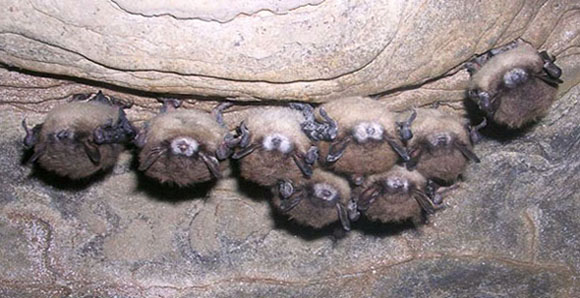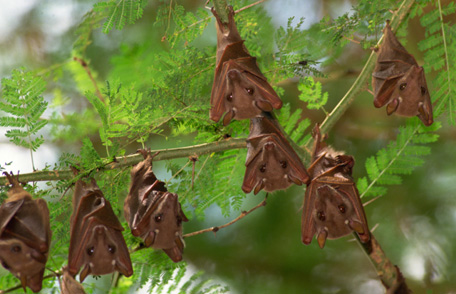
Super Drone Inspections Now Available
Canton Wildlife now offers super drone inspections for those hard to reach roofs using 360° high definition imaging with zoom capabilities.
Contact Us To Schedule An Inspection


Reprinted from the National Park Service
White-nose syndrome (WNS) is the fungal disease killing bats in North America. Research indicates the fungus that causes WNS, Pseudogymnoascus destructans, is likely exotic, introduced from Europe. What started in New York in 2006 has spread to more than half of the United States and five Canadian provinces by August 2016, leaving millions of dead bats in its path. WNS causes high death rates and fast population declines in the species affected by it, and scientists predict some regional extinction of bat species. These include the once numerous little brown bat (Myotis lucifugus) and federally listed Indiana bat (Myotis sodalis) and northern long-eared bat (Myotis spetentronalis).
Researchers call the disease “white-nose syndrome” (WNS) because of the visible white fungal growth on infected bats’ muzzles and wings. This cold-loving fungus infects bats during hibernation, when the bats reduce their metabolic rate and lower their body temperature to save energy over winter. Hibernating bats affected by WNS wake up to warm temperatures more frequently, which results in using up fat reserves and then starvation before spring arrives.
The visible signs of WNS show the disease is in a later stage. These bats are already dealing with life-threatening physical function changes, such as acidification and dehydration. Even before the infected bats start to wake more often, infection with the fungus causes bats to use energy twice as fast as healthy bats, according to research from scientists at University of Wisconsin.
The fungus that causes WNS is transmitted a few different ways. Bats can catch the fungus from physical contact with infected bats. Also, bats can pick up the fungus from the surfaces of the cave or mine where they’re hibernating. Humans can spread the fungus from one hibernaculum to another by accidentally carrying the fungus on shoes, clothing, or gear. So it’s really important to not bring clothing or gear into a WNS-free site that was previously used in a WNS-affected site. For this reason, it’s crucial to correctly remove the fungus from your gear and shoes before and after entering caves. Learn how to decontaminate your caving gear.
Current evidence indicates that WNS is not transmissible from bats to humans. Studies have shown that the fungus grows only at cold temperatures (41-68 degrees F) that are much lower than that of the human body. Also, no human infections have ever been documented after exposure to WNS-infected bats or caves.
Although WNS does not cause illness in humans, a small percentage of bats can be infected with other dangerous diseases, such as rabies. Bats infected with either WNS or rabies may exhibit unusual behavior (e.g. erratic flying), which increases the risk for bat-human contact and exposure. Additionally, declines in bat populations can impact human health indirectly since humans depend on bats for important ecosystem services such as controlling pest insects.
If you need help with Humane Wildlife Removal, contact us today.

Bats play an important role in our ecosystem. However, they are also associated with diseases deadly to humans. Learn how you can stay safe when bats are near.
Diseases Spread by Bats
Several highly fatal diseases have been linked to bats.
Rabies is perhaps the most well known disease associated with bats. Along with animals such as dogs, foxes, raccoons, and skunks, bats are one of the primary animals that transmit rabies.
An exposure to rabies most commonly occurs when a person is bitten by a rabid animal. It can also be transmitted when the saliva from a rabid animal comes in contact with a person’s mouth, eyes, nose, or a fresh wound.
When a person is exposed to rabies, timely administration of a vaccine known as post-exposure prophylaxis (PEP) can prevent infection. Once a person becomes infected and symptoms begin to occur, rabies is almost always fatal. Each year in the United States, up to 30,000 persons receive PEP due to potential exposure to a rabid animal, including bats.
Histoplasmosis is another disease associated with bats. Its symptoms vary greatly, but the disease primarily affects the lungs. Occasionally, other organs are affected. When this happens it can be fatal if untreated.
In addition, Histoplasmosis is caused by a fungus that grows in soil and material contaminated with droppings from animals, including bats. Droppings, also known as bat guano, can contaminate the soil and cause infectious spores to be released when the soil is disturbed.
Even though it can be found throughout the world, it is widespread in certain areas of the U.S. and can be found in places that harbor large populations of bats, including caves.
While most infected persons have no apparent ill effects, antifungal medications are used to treat many forms of the disease.
Bats and Diseases around the World
Even though rabies and histoplasmosis can be found all over the world, some diseases associated with bats are found exclusively in certain regions of the world. Notably, research suggests that bats might be the source of several hemorrhagic fevers, which affect multiple organ systems in the body and often lead to life-threatening diseases.
One of these diseases is Marburg hemorrhagic fever, which is found exclusively in Africa. Past outbreaks have shown that Marburg Hemorrhagic Fever kills up to 90% of those infected.
While the natural host had for years been unknown, new research suggests that fruit bats are a natural source of this virus, and the virus has been isolated repetitively from fruit bats in Uganda.
The same may be true for Ebola hemorraghic fever. The virus that causes this disease is often referred to as the “cousin” of Marburg virus, since they are the only distinct viruses that belong to a group of viruses known as filoviruses. Like Marburg, Ebola is highly fatal and is found mostly in Africa. Recent studies indicate that, as with Marburg, bats are likely to be a natural source of this virus, although no Ebola virus has been isolated from bats.
Two other viruses – Nipah (which causes Nipah virus encephalitis) and Hendra (which causes Hendra virus disease) – are also associated with bats. Research suggests that Hendra virus is associated with fruit bats (commonly called flying foxes) in Australia. Nipah and related viruses are also associated with the same group of bats in Southeast Asia and parts of Africa, although outbreaks of disease in humans have so far been limited to Malaysia, Singapore, India, and Bangladesh. Both viruses can cause severe respiratory and neurologic disease in humans.
Another group of viruses known as coronaviruses have been detected in multiple species of bats. Coronavirus infection can sometimes cause mild respiratory illness in humans, but these viruses were also implicated in the outbreak of Severe Acute Respiratory Syndrome (SARS) in Southeast Asia. While bats do not carry or transmit SARS, research has linked coronaviruses to bats in countries all over the world.
In addition, Lyssaviruses have been discovered on every inhabited continent. This group of viruses causes rabies, in addition to other diseases that can be fatal to humans. While current rabies vaccines are effective against many of the viruses in this group, several Lyssaviruses identified in Africa and Asia primarily associated with bats cannot be prevented with current rabies vaccines.
Further studies may shed light on the role of bats as the source of these viruses and their ability to transmit diseases caused by these viruses to humans.
Stay Alert in Areas where Bats are Found
Many bats rely on cave roosts and are often found in groupings that can number in the millions. Cave explorers, spelunkers, divers, and others whose activities take them into or around caves should exercise caution when in these environments.
Make sure be on the lookout for bats, which often roost or hibernate at high points within caves. It is also important to avoid being near or coming into contact with bat droppings. When possible, avoid entering caves that are known to contain populations of bats.
In addition, it might be a good idea to bring a flashlight into the cave to help better identify the presence of bats or other animals. If bats are present in the immediate area, consider leaving the cave or moving to an area of the cave where there are no bats.
Some bats also roost in tree cavities or foliage, and might be spotted in areas where outdoor activities take place, such as hiking or camping. While there have been instances of humans exposed to rabid bats , most bats in a natural setting are not rabid and, in many outdoor situations, the presence or sighting of bats is common and normal.
However, precautions can be taken at outdoor locales to help minimize the risk of exposure to bats and their excretions:
When possible, prevent bats from entering outdoor living quarters and other occupied spaces. Consider “bat-proofing” your living space.
Screens or mosquito netting can provide a useful barrier against direct bat contact.
Teach children to never to handle live or dead bats, as well as any unfamiliar wild or domestic animals (even if they appear friendly). Tell them to report any contact or unusual animal behavior to an adult right away.
In some settings, materials contaminated with bat droppings may have to be disposed of or decontaminated. In these situations, local and state authorities can provide more information on the requirements for the removal, transportation, and disposal of contaminated material. Clean-up of areas contaminated with bat droppings should not be attempted by non-trained personnel, and proper personal protective equipment (PPE), including respirator, mask, gown, and gloves, should be worn by anyone handling the potentially infectious material.
Take Steps to Keep Bats Out of Your Home
Some bats live in buildings, and may continue to do so with little risk to inhabitants if they are unable to access living areas and the potential for contact with people is low.
However, bats should always be prevented from entering rooms of your home. As noted above, “bat proofing” your home or living quarters can prevent bats from using a home for a roosting site. For best results, contact an animal control or wildlife conservation agency and ask for assistance.
If you choose to do the “bat-proofing” yourself, here are some suggestions:
Carefully examine your home for holes that might allow bats entry into your living quarters.
Any openings larger than a quarter-inch by a half-inch should be caulked.
Use window screens, chimney caps, and draft-guards beneath doors to attics.
Fill electrical and plumbing holes with stainless steel wool or caulking. Ensure that all doors to the outside close tightly.
Most bats leave in the fall or winter to hibernate, so these are the best times to “bat-proof” your home. During summer, many young bats are unable to fly. If you exclude adult bats during this time, the young may be trapped inside.
Safely Capture Bats and Dispose of Dead Bats
If a bat is present in your home, contact us for assistance. It may be important to capture the bat for rabies testing, especially if a potential bite or exposure has occurred. Sometimes, professional help may be unavailable. In such cases, use precautions to capture the bat safely, as described below.
To begin, you will need:
leather work gloves (put them on)
small box or coffee can
piece of cardboard
tape
The steps you should take to capture the bat are:
When the bat lands, approach it slowly, while wearing the gloves, and place the box or coffee can over it.
Slide the cardboard under the container to trap the bat inside.
Tape the cardboard to the container securely, and punch small holes in the cardboard, allowing the bat to breathe.
When no potential exposure has occurred, the bat can be safely released outside. If a bite or exposure to saliva (e.g., into a person’s mouth, eyes, or a fresh wound) has occurred, your health department or animal-control authority should be contacted to make arrangements for rabies testing.
If you come across a dead bat, call animal control services to see if they can safely remove the animal. In some instances, such services might not be immediately available. Under these circumstances, follow the below steps to safely discard the dead bat.
Get a cardboard box or Tupperware container
Place it over the bat
Slide a cardboard or plastic lid under the box/container so that the bat is confined within.
Remove it from the area until animal control services can arrive to safely dispose of the bat.
Treatment After a Potential Exposure
If you are bitten or saliva from a bat gets into your eyes, nose, mouth, or wounds, wash the affected area thoroughly and get medical attention immediately.
Bats have small teeth that may leave marks not easily seen (see picture). Although many people know if they have been bitten by a bat, there are certain circumstances when a person might not be aware or able to tell if a bite has occurred. For example:
If a person awakes to find a bat in the room
If you find a bat in a room with an unattended child
If you see a bat near a person with a disability
If the above occurs, get immediate medical attention. In all circumstances, contact local or state health departments for assistance with medical advice and testing bats for rabies. When it cannot be ruled out that the bat is free from rabies and an exposure has occurred, (PEP) may need to be considered.
When bat droppings, saliva, or other secretions are believed to be nearby, closely monitor your health, especially any fever, chills, headache, or muscle pain.
If these symptoms appear after being in an area when bats might have been nearby, seek medical attention and be sure to note your presence in these areas. Be sure to also note any travel that has recently taken place, especially to African countries. This is especially important if it has been less than a month since a potential exposure to bats.
Living Safely With Bats
Even though bats sometimes spread diseases to people, they are able to peacefully co-exist with humans and provide us with many benefits.
Worldwide, bats are a major predator of night-flying insects, including pests that cost farmers billions of dollars annually. Throughout the tropics, seed dispersal and pollination activities by bats are vital to rain forest survival. In addition, studies of bats have contributed to medical advances including the development of navigational aids for the blind. Unfortunately, many local populations of bats have been destroyed and many species are now endangered.
The best protection we can offer these unique animals is to learn more about their habits and recognize the value of living safely with them.

Raccoons can be extremely dangerous, so contact us immediately if you one in your home.
Here are some tips to see if you have raccoons:
Is there anybody in there?
To determine if an opening is being used, block the hole loosely with wadded newspaper. Leave in place for two to three days.
If the newspaper goes undisturbed, and the weather has not been particularly cold or stormy, no one is using it as an entryway. If the newspaper is pushed out of place, someone has moved in.
Raccoon tenants
Don’t try to trap and relocate the family yourself. It almost always leads to separation (and probably death) of the young raccoons, unless done by a professional who knows how to reunite mothers with their offspring. The reunion approach allows the mother move her young to another den site at her own pace.
→ Contact Canton Wildlife Removal to safely and humanely remove the raccoons and their young.
A note about raccoon waste:
In places where raccoons have lived for a long time, feces may have accumulated. Take care to avoid exposure to roundworm eggs, which can be found in raccoon feces. For safety’s sake, ideally, you should hire a professional service to clean up a raccoon latrine.
→ Canton Wildlife Removal offers powerwashing to clean up after removing animals.
Bottom Line:
Raccoons are quite dangerous. Raccoons can carry many serious diseases including rabies. Although incidents of rabid raccoons attacking humans are rare, you don’t want to risk your families health and safety. Raccoons carry two other diseases, roundworm and leptospirosis, that can also be transmitted to humans and pets. So if you suspect raccoons in your house, call us today: (774) 204-1776.